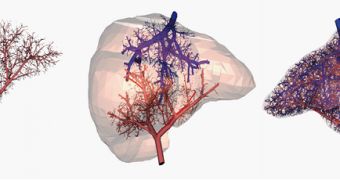3D printing is making tremendous advancements these days and in the process, it is revolutionizing a field of major importance – the medical one.
Bioprinting is an offshoot of 3D printing that aims to allow scientists and medical researchers to build a viable human organ which can be used for transplanting into patients affected by major diseases and trauma injuries.
Now, researchers from the University of Sydney, Harvard, Stanford and MIT have announced a major breakthrough in the field of bioprinting transplantable tissue, reports ScienceDaily. The team has managed to bioprint artificial vascular networks akin to the body’s own circulatory system, which sustain the growth of complex tissue.
“Thousands of people die each year due to a lack of organs for transplantation. Many more are subjected to the surgical removal of tissue or organs due to cancer, or they’re involved in accidents with large fractures and injuries,” explained University of Sydney researcher, Dr. Luiz Bertassoni.
So imagine being brought into the emergency room, evaluated and then have a full organ bioprinted for you, complete with cells, proteins and blood vessels, just by virtue of someone pushing a button.
In achieving this end, the most important challenge the researchers had to deal with was the networking of cells with a blood supply. The team is currently working with “prototypes” and is actively improving upon the base model.
Since cells need nutrients, oxygen and a waste disposal system in order to thrive, a functional transportation system setup is essential to their survival.
“Cells die without an adequate blood supply because blood supplies oxygen that’s necessary for cells to grow and perform a range of functions in the body.”
The good news is that the research team has managed to find a way to achieve this. In the process of doing so, they made us a of high-tech “bio-printer” and fabricated a multitude of interconnected tiny fibers from which the artificial blood vessels were actually made.
Then they immersed the 3D printed structure with a cell-rich protein-based material, which solidified when exposed to light.
The last step of the process involved removing the 3D printed structure, leaving a network of channels coated with human endothelial cells. Then nature took hold and the network organized itself into a stable blood capillary system in less than one week.
The breakthrough hopes to help quicken the pace of 3D printing research, in the hopes that someday, not long from now, patients in need of a transplant won’t be put on long agonizing donor-finding lists.

 14 DAY TRIAL //
14 DAY TRIAL //